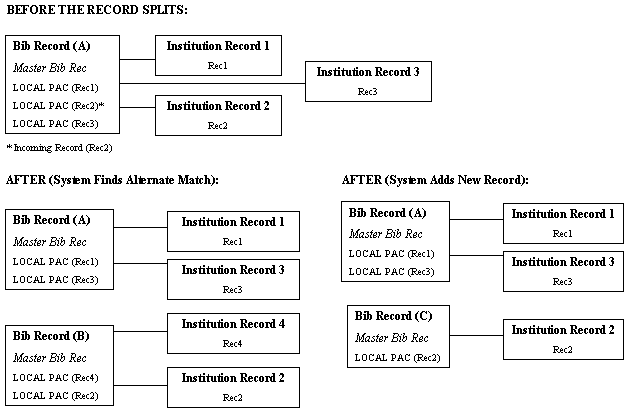Modifying an INN-Reach Catalog Record
After the INN-Reach Central Server matches an incoming bibliographic record to an existing bibliographic record in the INN-Reach Catalog and determines which record is the master record, the system performs one of the following actions:
Splitting an Existing Record
If the system matches an incoming record to an existing record in the INN-Reach Catalog based on record number, the system verifies the previous match (which resulted in an earlier version of the incoming record merging with the existing record) by comparing the current values of the Primary Match Fields. If the incoming record contains a change to the Primary Match Field, the incoming record can be sufficiently different from the master record it formerly matched that it is no longer appropriate to treat it as the same bibliographic entity. In such a case, the incoming record "splits" from the existing bibliographic record. The system treats the "split record" as it would a new incoming record and attempts to match the record to other records in the INN-Reach Catalog based on the new Primary Match Field. If it cannot find any other records that match, the system adds the split record as a new master bibliographic record.
For example, if the incoming record (Record 1) previously matched an existing record (Record 2), but now has differing Primary Match Field values, the system splits Record 1 from Record 2 and searches for matching records in the database based on Record 1's new Primary Match Field. If the system finds that Record 1 now matches another existing record (Record 3), the system merges Records 1 and 3 according to the master ownership conditions of those records. If the system finds that Record 1 now no longer matches any existing records in the database, the system adds Record 1 as a master bibliographic record.
For example:

Overlaying an Existing Record
The incoming record overlays the existing master record under one of the following conditions:
- The incoming record is already the master record (that is, the existing record is an earlier version of the incoming record). The updated information in the incoming record overlays the earlier version.
- The system determines that the incoming record should be the master record. The incoming record becomes the new master record. The contributing site becomes the new master owner. The new master owner retains all the previous master record's links to existing institution records.
Master Owner Feature
If the owning site has master ownership of the master bibliographic record, the incoming record does not overlay the existing record unless it is contributed by the master owning site. The master owner retains ownership of the master bibliographic record, even if an incoming record from another Local Server would normally replace the master bibliographic record. For more information, see Contributing Records as the Master Owner.
Updating an Existing Record
If the system does not split or overlay the existing master record, it updates the existing master record, as follows:
- If the incoming record is new, the system adds a LOCAL PAC field to the master record.
- If the incoming record has been previously contributed, the system updates the existing LOCAL PAC field for that record.